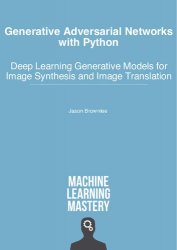 Название: Generative Adversarial Networks with Python
Название: Generative Adversarial Networks with PythonАвтор: Jason Brownlee
Издательство: Jason Brownlee
Год: 2019
Формат: PDF
Страниц: 654
Размер: 11,2 Mb
Язык: English
The study of Generative Adversarial Networks (GANs) is new, just a few years old. Yet, in just a few years GANs have achieved results so remarkable that they have become the state-of-the-art in generative modeling. The field is so new that there are no good theories on how to implement and configure the models. All advice for applying GAN models is based on hard-earned empirical findings, the same as any nascent field of study. This makes it both exciting and frustrating.
It’s exciting because although the results achieved so far are significant. Such as the automatic synthesis of large photo-realistic faces and translation of photographs from day to night. We have only scratched the surface on the capabilities of these methods. It’s frustrating because the models are fussy and prone to failure modes, even after all care is taken in the choice of model architecture, model configuration hyperparameters, and data preparation.
I carefully designed this book to give you the foundation required to begin developing and applying generative adversarial networks quickly. We skip over many false starts and interesting diversions in the field and focus on the precise tips, tricks, and hacks you need to know in order to develop and train stable GAN models. We also visit state-of-the-art models and discover how we can achieve the same impressive results ourselves. There are three key areas that you must understand when working with GANs; they are:
- How to develop basic GAN models. This includes training unsupervised GANs for image synthesis and the heuristics required to configure and successfully train the generative models.
- How to evaluate GAN models. This includes widely adopted qualitative and quantitative techniques for evaluating the quality of synthesized images.
- How to develop alternate GAN models. This includes the use of alternate loss functions and the use of class-conditional information in the models.
These three key areas are a required foundation for understanding and developing the more advanced GAN techniques. We then build upon these key areas and explore state-of-the-art models for image translation: specifically the Pix2Pix and CycleGAN models. These key topics provide the backbone for the book and the tutorials you will work through. I believe that after completing this book, you will have the skills and knowledge required to bring generative
adversarial networks to your own projects.